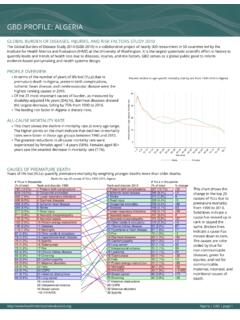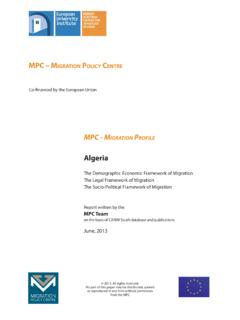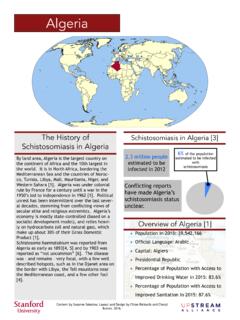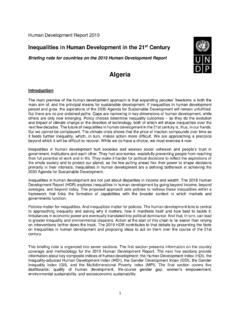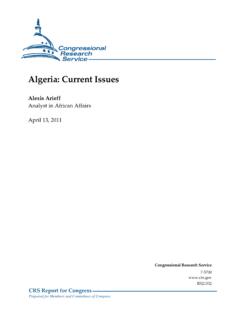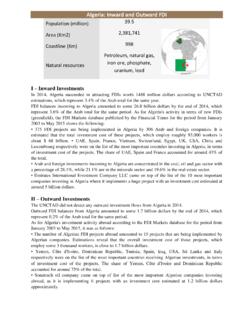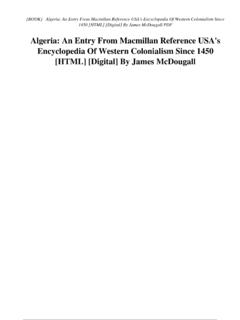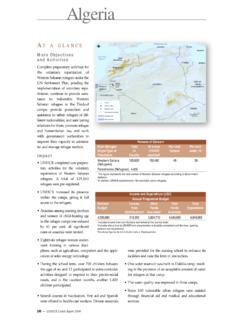Transcription of Algeria: WHO and UNICEF estimates of immunization …
1 algeria : WHO and UNICEF estimates of immunization coverage : 2017 revision July 7, 2018; page 1 WHO and UNICEF estimates of national immunization coverage - next revision available July 15, 2019 data received as of July 4, 2018. algeria : WHO and UNICEF estimates of immunization coverage : 2017 revision BACKGROUND NOTE: Each year WHO and UNICEF jointly review reports submitted by Member immunization and/or campaign or (ii) a sequential schedule of IPV followed by OPV, WHO and States regarding national immunization coverage , finalized survey reports as well as data from the UNICEF estimates for IPV1 reflect coverage with at least one routine dose of IPV among infants published and grey literature. Based on these data, with due consideration to potential biases and the <1 year of age among countries.
2 For countries utilizing IPV containing vaccine use only, , no views of local experts, WHO and UNICEF attempt to distinguish between situations where the recommended dose of OPV, the WHO and UNICEF estimate for IPV1 corresponds to coverage available empirical data accurately reflect immunization system performance and those where the data for the 1st dose of IPV. are likely to be compromised and present a misleading view of immunization coverage while jointly Production of IPV coverage estimates , which begins in 2015, results in no change of the estimating the most likely coverage levels for each country. estimated coverage levels for the 3rd dose of polio (Pol3). For countries recommending routine immunization with a primary series of three doses of IPV alone, WHO and UNICEF estimated WHO and UNICEF estimates are country-specific; that is to say, each country's data are reviewed Pol3 coverage is equivalent to estimated coverage with three doses of IPV.
3 For countries with a individually, and data are not borrowed from other countries in the absence of data. estimates are not sequential schedule, estimated Pol3 coverage is based on that for the 3rd dose of polio vaccine based on ad hoc adjustments to reported data; in some instances empirical data are available from a regardless of vaccine type. single source, usually the nationally reported coverage data. In cases where no data are available for a MCV1: percentage of surviving infants who received the 1st dose of measles containing vaccine. In given country/vaccine/year combination, data are considered from earlier and later years and countries where the national schedule recommends the 1st dose of MCV at 12 months or later interpolated to estimate coverage for the missing year(s).
4 In cases where data sources are mixed and based on the epidemiology of disease in the country, coverage estimates reflect the percentage of show large variation, an attempt is made to identify the most likely estimate with consideration of the children who received the 1st dose of MCV as recommended. possible biases in available data. For methods see: MCV2: percentage of children who received the 2nd dose of measles containing vaccine according to *Burton et al. 2009. WHO and UNICEF estimates of national infant immunization coverage : methods the nationally recommended schedule. and processes. RCV1: percentage of surviving infants who received the 1st dose of rubella containing vaccine. Co *Burton et al. 2012. A formal representation of the WHO and UNICEF estimates of national verage estimates are based on WHO and UNICEF estimates of coverage for the dose of measles immunization coverage : a computational logic approach.
5 Containing vaccine that corresponds to the first measles-rubella combination vaccine. Nationally *Brown et al. 2013. An introduction to the grade of confidence used to characterize uncertainty around reported coverage of RCV is not taken into consideration nor are the data represented in the the WHO and UNICEF estimates of national immunization coverage . accompanying graph and data table. HepBB: percentage of births which received a dose of hepatitis B vaccine within 24 hours of delivery. DATA SOURCES. estimates of hepatitis B birth dose coverage are produced only for countries with a universal ADMINISTRATIVE coverage : Reported by national authorities and based on aggregated birth dose policy. estimates are not produced for countries that recommend a birth dose to administrative reports from health service providers on the number of vaccinations administered infants born to HepB virus-infected mothers only or where there is insufficient information to during a given period (numerator data) and reported target population data (denominator data).
6 Determine whether vaccination is within 24 hours of birth. May be biased by inaccurate numerator and/or denominator data. HepB3: percentage of surviving infants who received the 3rd dose of hepatitis B containing vaccine OFFICIAL coverage : Estimated coverage reported by national authorities that reflects their following the birth dose. assessment of the most likely coverage based on any combination of administrative coverage , Hib3: percentage of surviving infants who received the 3rd dose of Haemophilus influenzae type b survey-based estimates or other data sources or adjustments. Approaches to determine containing vaccine. OFFICIAL coverage may differ across countries. RotaC: percentage of surviving infants who received the final recommended dose of rotavirus vaccine, SURVEY coverage : Based on estimated coverage from population-based household surveys among which can be either the 2nd or the 3rd dose depending on the vaccine.
7 Children aged 12-23 months or 24-35 months following a review of survey methods and results. PcV3: percentage of surviving infants who received the 3rd dose of pneumococcal conjugate vaccine. Information is based on the combination of vaccination history from documented evidence or In countries where the national schedule recommends two doses during infancy and a booster caregiver recall. Survey results are considered for the appropriate birth cohort based on the dose at 12 months or later based on the epidemiology of disease in the country, coverage period of data collection. estimates may reflect the percentage of surviving infants who received two doses of PcV prior to the 1st birthday. ABBREVIATIONS YFV: percentage of surviving infants who received one dose of yellow fever vaccine in countries where BCG: percentage of births who received one dose of Bacillus Calmette Guerin vaccine.
8 YFV is part of the national immunization schedule for children or is recommended in at risk areas; coverage estimates are annualized for the entire cohort of surviving infants. DTP1 / DTP3: percentage of surviving infants who received the 1st / 3rd dose, respectively, of diphtheria and tetanus toxoid with pertussis containing vaccine. Disclaimer: All reasonable precautions have been taken by the World Health Organization and Pol3: percentage of surviving infants who received the 3rd dose of polio containing vaccine. May be United Nations Children's Fund to verify the information contained in this publication. However, either oral or inactivated polio vaccine. the published material is being distributed without warranty of any kind, either expressed or implied. The responsibility for the interpretation and use of the material lies with the reader.
9 In IPV1: percentage of surviving infants who received at least one dose of inactivated polio vaccine. In no event shall the World Health Organization or United Nations Children's Fund be liable for countries utilizing an immunization schedule recommending either (i) a primary series of three damages arising from its use. doses of oral polio vaccine (OPV) plus at least one dose of IPV where OPV is included in routine July 7, 2018; page 2 WHO and UNICEF estimates of national immunization coverage - next revision available July 15, 2019 data received as of July 4, 2018. algeria - BCG. Description: 2017: Estimate based on reported administrative data. No nationally representative household survey within the last 5 years. WHO and UNICEF recommend a high-quality survey to confirm reported levels of coverage .
10 Official government estimates are higher than reported administrative coverage without explanation. Estimate challenged by: D- 2016: Estimate based on reported administrative data. Official government estimates are higher than reported administrative coverage without explanation. Estimate challenged by: D- 2015: Estimate based on coverage reported by national government. GoC=R+ D+. 2014: Estimate based on coverage reported by national government. GoC=R+ D+. 2013: Estimate based on coverage reported by national government. Estimate challenged by: D- 2012: Estimate based on coverage reported by national government. Estimate challenged by: D- 2011: Estimate based on coverage reported by national government supported by survey. Survey evidence of 98 percent based on 1 survey(s).










